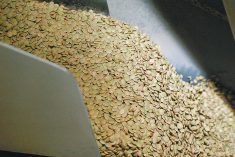The new canola meal contract is now running on the rails, but the Winnipeg Commodity Exchange and the grain trade can’t yet tell whether it will build up enough steam to keep going.
To July 9 there had been about 250 trades on the contract, but more than half were conducted on the first day and it hasn’t traded every day. By contrast, the canola seed contract has thousands of trades a day
“The jury’s still out on whether it will work because we definitely need bigger volumes than we’ve seen,” said David Reimann, a floor trader with Benson Quinn-GMS.
Read Also

Canola support gets mixed response
A series of canola industry support measures announced by the federal government are being met with mixed reviews.
“If we could get this thing some liquidity, then I think this thing has hope.”
The exchange’s new products committee came up with the contract after noticing there was a lot of basis volatility between soybean meal and canola meal prices.
Canola oil and meal generally trade off of soybeans. Where there’s basis volatility there’s an opportunity for risk management, so the exchange took it by introducing the canola meal contract.
The new contract also complements the canola futures contract, which dominates the WCE.
Many of the same buyers and sellers of canola could be involved in the canola meal contract, exchange officials think.
Before the contract launch exchange officials said they couldn’t predict how it would perform.
“That’s up to the traders,” said Bruce Love, WCE director of marketing.
“A lot of them say they’re interested in this, so it’s up to them.”
Lyndon Peters, exchange economist, said the contract fills a void and should find users.
“We think this meets a need, and that’s what we’ve been told,” said Peters.
Canola meal is used as livestock feed. It is popular with dairy farmers and is also fed to hogs, poultry and beef cattle.
Reimann said canola meal has traditionally been traded at about a 35 percent discount to soybean meal in the cash market, and that’s the way it’s working out in the futures.
Since its launch, canola meal has sold for between 65 and 67 percent of soybean meal, although it went as high as 69.5 percent on July 6.
Reimann said the truest value of the meal will be sorted out after it becomes clear which livestock feed market uses it most.
“Because the different uses have different values, we have to determine who uses this the most, and I would assume the price would gravitate somewhat closer to what the largest user is usually paying,” said Reimann.
The main users of the contract so far appear to be small commercial buyers.
The canola crushers, who are left with the meal after squeezing out the oil, started things off.
“I think the crushers have tried to get this market going,” said Reimann.
“We haven’t seen a lot of end users lining up yet. The end user is looking to see whether it will start trading with any sort of volume. Then they’ll step up and use it.”
Reimann said traders expect a few months of low volume trading before the contract either soars or crashes.
“It’s a classic problem with any new contract. People say, ‘if it starts trading, I’ll trade it.’ But someone has to go first.”
Reimann doesn’t expect big players to step in for four to six months. If they haven’t stepped in after a year, the contract would be in trouble.















